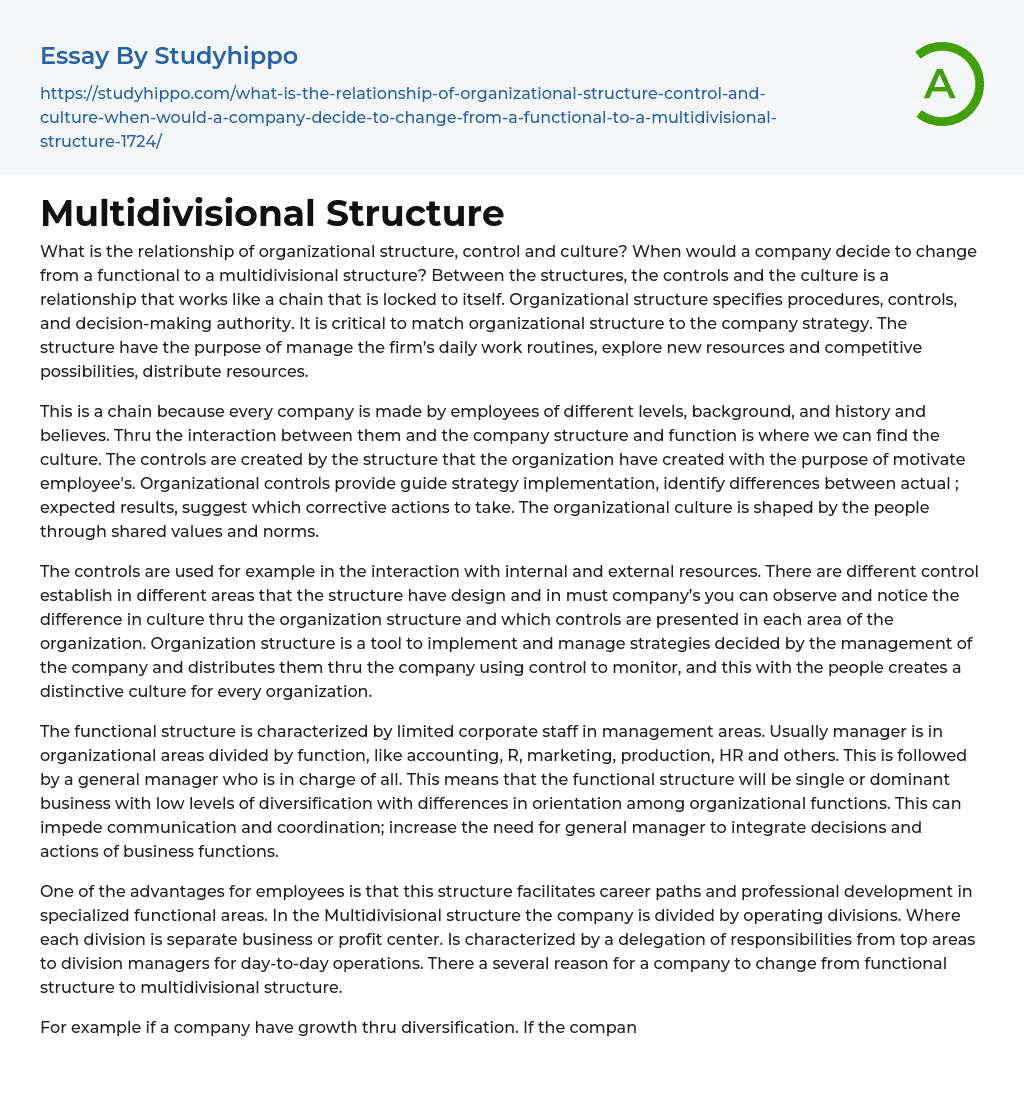What is the relationship of organizational structure, control and culture? When would a company decide to change from a functional to a multidivisional structure? Between the structures, the controls and the culture is a relationship that works like a chain that is locked to itself. Organizational structure specifies procedures, controls, and decision-making authority. It is critical to match organizational structure to the company strategy. The structure have the purpose of manage the firm’s daily work routines, explore new resources and competitive possibilities, distribute resources.
This is a chain because every company is made by employees of different levels, background, and history and believes. Thru the interaction between them and the company structure and function is where we can find the culture. The controls are created by the structure that the organization have created with the purpose of motivate employee's. Organi
...zational controls provide guide strategy implementation, identify differences between actual ; expected results, suggest which corrective actions to take. The organizational culture is shaped by the people through shared values and norms.
The controls are used for example in the interaction with internal and external resources. There are different control establish in different areas that the structure have design and in must company’s you can observe and notice the difference in culture thru the organization structure and which controls are presented in each area of the organization. Organization structure is a tool to implement and manage strategies decided by the management of the company and distributes them thru the company using control to monitor, and this with the people creates a distinctive culture for every organization.
The functional structure is characterized by limited corporate staff in management areas. Usuall
manager is in organizational areas divided by function, like accounting, R, marketing, production, HR and others. This is followed by a general manager who is in charge of all. This means that the functional structure will be single or dominant business with low levels of diversification with differences in orientation among organizational functions. This can impede communication and coordination; increase the need for general manager to integrate decisions and actions of business functions.
One of the advantages for employees is that this structure facilitates career paths and professional development in specialized functional areas. In the Multidivisional structure the company is divided by operating divisions. Where each division is separate business or profit center. Is characterized by a delegation of responsibilities from top areas to division managers for day-to-day operations. There a several reason for a company to change from functional structure to multidivisional structure.
For example if a company have growth thru diversification. If the company is in need for corporate officers to be able to more accurately monitor the performance of each business and simplifies the problem of control. In monitoring aspect multidivisional structure facilitates comparisons between divisions and which improves the resource allocation process. It also used if the company needs to stimulates managers of poorly performing divisions to look for ways of improving performance.
Managers use a combination of strategic controls and financial controls to strike a balance between competing among divisions for scarce capital resources. Every company desire to maximize overall company performance and results. If a company decides to change it have to take in consideration if the decisions are centralized or decentralized and look for a balance. You have to remember that
a company is an ever changing being that a structure could evolve over time with changes in strategy, diversification and the influence of the competition as well as industry.
- Being A Leader essays
- Servant Leadership essays
- Leadership Experience essays
- Leadership Qualities essays
- Board Of Directors essays
- Brand Management essays
- Business Ethics essays
- Business Management essays
- Change Management essays
- Comparative Analysis essays
- Decision Making essays
- Dispute Resolution essays
- Knowledge Management essays
- Leadership essays
- Leadership and Management essays
- Manager essays
- Operations Management essays
- Performance Management essays
- Product Management essays
- Project Management essays
- Quality Management essays
- Risk essays
- Risk Management essays
- Scientific Management essays
- Stress Management essays
- supply chain management essays
- Time Management essays
- Total Quality Management essays
- Collective Bargaining essays
- Corporate Culture essays
- Hard Work essays
- Job Satisfaction essays
- Organizational Culture essays
- Organizational Structure essays
- Sweatshops essays
- Workforce essays
- Working capital essays
- Working Class essays
- Working Time essays
- Workstation essays
- Accounting essays
- Andrew Carnegie essays
- Automation essays
- Business Cycle essays
- Business Intelligence essays
- Business Model essays
- Business Operations essays
- Business Software essays
- Cooperation essays
- Cooperative essays




